 |
 |
 |
 |
 |
 |
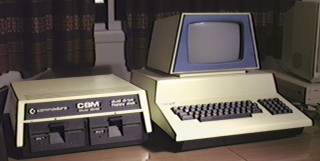 One of my favourite pieces of working computer hardware: the Commodore PET
2001. The machine in the photo has the full size keyboard and the upgrade ROMs
which allow it to use a disk drive. The blue trim around the monitor, the
blue-white display, and certain parts on the motherboard identify this as one
of the earliest models of PET. Judging by the date codes on the chips inside,
this machine was probably constructed in the first few weeks of 1978.
Unfortunately, all of the RAM chips were fried, and the fuse and fuse cap were
missing when I got it. The sticker was removed from its front by a previous
caretaker, and apparently it now lives on a guitar. I was told that this
particular PET was the very first personal computer in use at Air Canada. I
can't thank the people involved in its rescue enough, especially Joe Thiemann
who passed this machine on to me because he didn't have enough room for it at
home (and he already has a SuperPET).
One of my favourite pieces of working computer hardware: the Commodore PET
2001. The machine in the photo has the full size keyboard and the upgrade ROMs
which allow it to use a disk drive. The blue trim around the monitor, the
blue-white display, and certain parts on the motherboard identify this as one
of the earliest models of PET. Judging by the date codes on the chips inside,
this machine was probably constructed in the first few weeks of 1978.
Unfortunately, all of the RAM chips were fried, and the fuse and fuse cap were
missing when I got it. The sticker was removed from its front by a previous
caretaker, and apparently it now lives on a guitar. I was told that this
particular PET was the very first personal computer in use at Air Canada. I
can't thank the people involved in its rescue enough, especially Joe Thiemann
who passed this machine on to me because he didn't have enough room for it at
home (and he already has a SuperPET).
The PET 2001 uses the MOS Technology 6502 microprocessor at a frequency of 1.0 MHz. This model has space for 8KB of memory on the motherboard, and is expandable up to 40KB via the 40-pin edge connector on the machine's right side. It features two cassette connectors, a "parallel user port" very similar to the user port on the later VIC-20, and an IEEE-488 interface to which disk drives, printers, and modems connect in a daisy-chain fashion.
The PET was one of what is often termed "The 1977 Trinity". The three first consumer-level microcomputers were released to the market in 1977: The Apple II, the TRS-80, and the PET. The PET seems to actually have been the first one shown off in prototype at a computer show (at the Consumer Electronics Show, January 1977), and Apple and Commodore both announced their machines at the first West Coast Computer Faire in April 1977, but I think Apple actually shipped machines to customers slightly earlier than Commodore, and I'm not sure how Radio Shack fits into things. [I'm still not sure about the exact ordering of events. Please e-mail me if you have difinitive sources on this, as I have several contradictory sources dating from the early 1980s but very little from the 1970s. The only 1970s source I have implies that both Radio Shack and Commodore beat Apple to market, but the popular histories say the opposite.]
When the PET was designed and built, MOS Technology was actually a subsidiary of Commodore. Chuck Peddle, the "Father of the PET", was also one of the chief creators of the 6502, upon which the Apple II, Atari 800, and many other computers of the era were based. Thus the PET was from the same mind as the CPU it was built around. Apparently it was jokingly said within Commodore that PET stood for "Peddle's Ego Trip". (The official meaning is "Personal Electronic Transactor".)
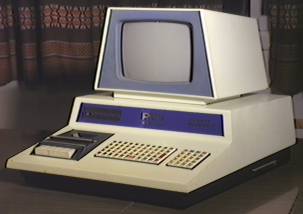 This is the other PET 2001 that is in the house. This one belongs to my
brother. I pulled the RAM chips, fuse, and fuse cap out of it to get my own
PET running. I would have preferred to keep this older model working instead
(small keyboard, internal cassette unit) but I think it has a broken trace on
the underside of the motherboard which causes it to crash with even slight
movements. It also contains the original ROM set, which won't allow me to use
my disk drives and doesn't contain a memory monitor. And let's face it - it's
much nicer to work on a PET with a large keyboard. When I have time, I
actually like to use my machines.
This is the other PET 2001 that is in the house. This one belongs to my
brother. I pulled the RAM chips, fuse, and fuse cap out of it to get my own
PET running. I would have preferred to keep this older model working instead
(small keyboard, internal cassette unit) but I think it has a broken trace on
the underside of the motherboard which causes it to crash with even slight
movements. It also contains the original ROM set, which won't allow me to use
my disk drives and doesn't contain a memory monitor. And let's face it - it's
much nicer to work on a PET with a large keyboard. When I have time, I
actually like to use my machines.
Oddly enough, this PET also has parts with 1978 date codes in it, so it's not as old as I was told. Also, one of the 6520s bears a date in 1981, which was about the time the machine went in for repairs. Perhaps not coincidentally, the suspected cracked trace on the motherboard is in the vicinity of this chip. Crashes usually occur when using the cassette unit or when pressing on the 6520 or nearby.
The problem was ultimately caused, I think, by the weak chip sockets in this particular machine (the other one holds onto its chips far more tightly). The chips had to be reseated frequently, and people would push too hard on them and flex the motherboard. I suspect that the shop misdiagnosed the machine's problem and replaced a good chip. The machine continued to have problems after the "repair". I was able to get it to run for a couple of months by being careful not to move it, once it was in a "safe" position, but I had to move it one day and it's been crazy ever since.
Apart from the small keyboard and the internal cassette unit, one other physical difference is the sharper corners on the case of the small keyboard PET. The large keyboard model is more rounded and less painful when you bang against it. <grin>
Here's a closeup of part of the small keyboard (also called "chiclet" keyboard). The keys are arranged in a perfect grid pattern. They are square pieces of plastic sitting on top of small rubber cups. The keytops seem to be made of metal, though I've never lifted one to make sure. This machine lived in a high school for a while, and then became my brother's personal computer, and so the keys have undergone a lot of wear. The symbols started to rub off so my brother coated them with some of my mother's nail polish to protect them. That's why you might be able to see some bubbles on the keys. |
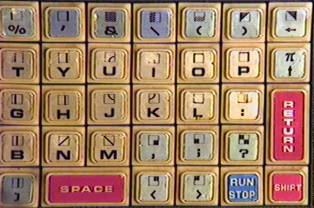
|
There are four key colours, all visible in the photo: red, dark blue, light blue, and yellowish-gray. I always thought the alphabetic keys were just gray, but Larry Anderson said that they were yellow, and they came out yellow in the photograph. A comparison with the white paint on the PET does indeed reveal that they are yellowish. The colours that my camera deliver can't always be trusted, but they're pretty good here.
Notice that there are no numbers on the top row. Numbers can only be typed on the numeric keypad.
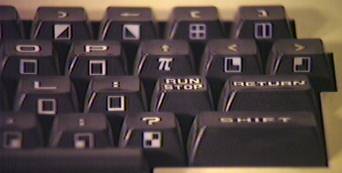
|
This is a fuzzy picture of part of the large keyboard. The graphics symbols are on the front face of the keys, like on the VIC-20 and C64 a few years later. The key arrangement of this keyboard is more similar to what we normally use today, but like on the chiclet keyboard, the numbers are only available on the numeric keypad. The cursor control keys are on the top row of the numeric keypad on both keyboards. |
In case you're wondering about the symbols on the keys, they are from the PETSCII character set. The PET (and other 8-bit Commodore machines) don't use standard ASCII. The table below shows what appears when values (here listed in hexadecimal) are POKEd to the PET's screen memory. There are two characters per number because the character set could be changed from the default graphics character set (which had only upper case alphabetic characters) to a character set that included both upper and lower case characters.
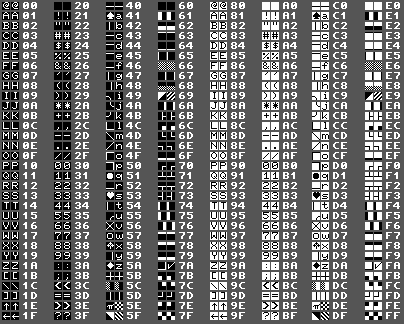
The character table above was actually taken from a VIC-20's character ROM, and modified to match what I saw on my PET. The characters in the range $01-$1A were exchanged with the characters in the range $41-$5A in the second character set. Likewise for the second character set, $81-$9A were exchanged with $C1-$DA. A later generation of PETSCII swapped upper case characters for lower case characters on the screen when changing to character mode, but this old PET keeps the upper case characters the same and only changes graphics characters to lower case alphabetic characters. Additionally, characters $1C and $9C were changed from the backslash on early PETs to the British Pound symbol that is found on the VIC-20.
Note that these characters are what appear on the screen when values are put directly into display memory, and don't represent the CHR$() values in BASIC. With the original PETs, CHR$(65) delivers "A" in character mode as it should. It is on later machines that CHR$(65) becomes "a". The older machines used something closer to ASCII than the newer ones.
On the PET, unlike the VIC-20 and Commodore 64, character sets could not be swapped from the keyboard. To be able to use lower case alphabetic characters, it was necessary to issue the command POKE 59468,14. To return to graphics mode, it was necessary to issue POKE 59468,12.
In case you're tempted to laugh at the odd condition of the PET character set and keyboard, it might be worth noting that the much more expensive Apple II didn't have character graphics or lower case characters without replacement chips and a modification to the keyboard, and the competing TRS-80 was also stuck in upper case.
|
The PET is somewhat famous for the way it opens up. There are hinges on the back of the (heavy steel) case, and the top lifts up like the hood of a car. The top is propped up by a rod that swings down from the top. I think I should have removed the dust from inside before taking this picture. <grin> |
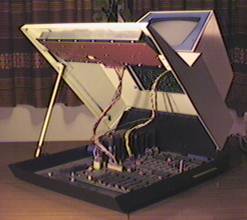
|

|
A picture from near the bottom left-hand corner of the motherboard. At the bottom of the image are two of the sixteen 6550 SRAMs that give the PET its 8 kilobytes of memory. I just hope that none of these things die, because there are no replacements! I think Commodore/MOS Techology was the only manufacturer, and they only made them for a short time in the 1970s. |
The PET 2001 was the first personal computer I ever used, and so it holds a special place in my collection. I generally only use it for playing Kathy Higby's "OURANOS!" these days, but when I get more time there are some programming and hardware projects that I want to try on it. I especially want to fix the small keyboard PET, and plug a modern SRAM into it to replace the scarce 6550s.
|
Other interesting PET items: |
Original PET manual CBM 2040 dual drive Internal memory board Music board PET to S100 interface |